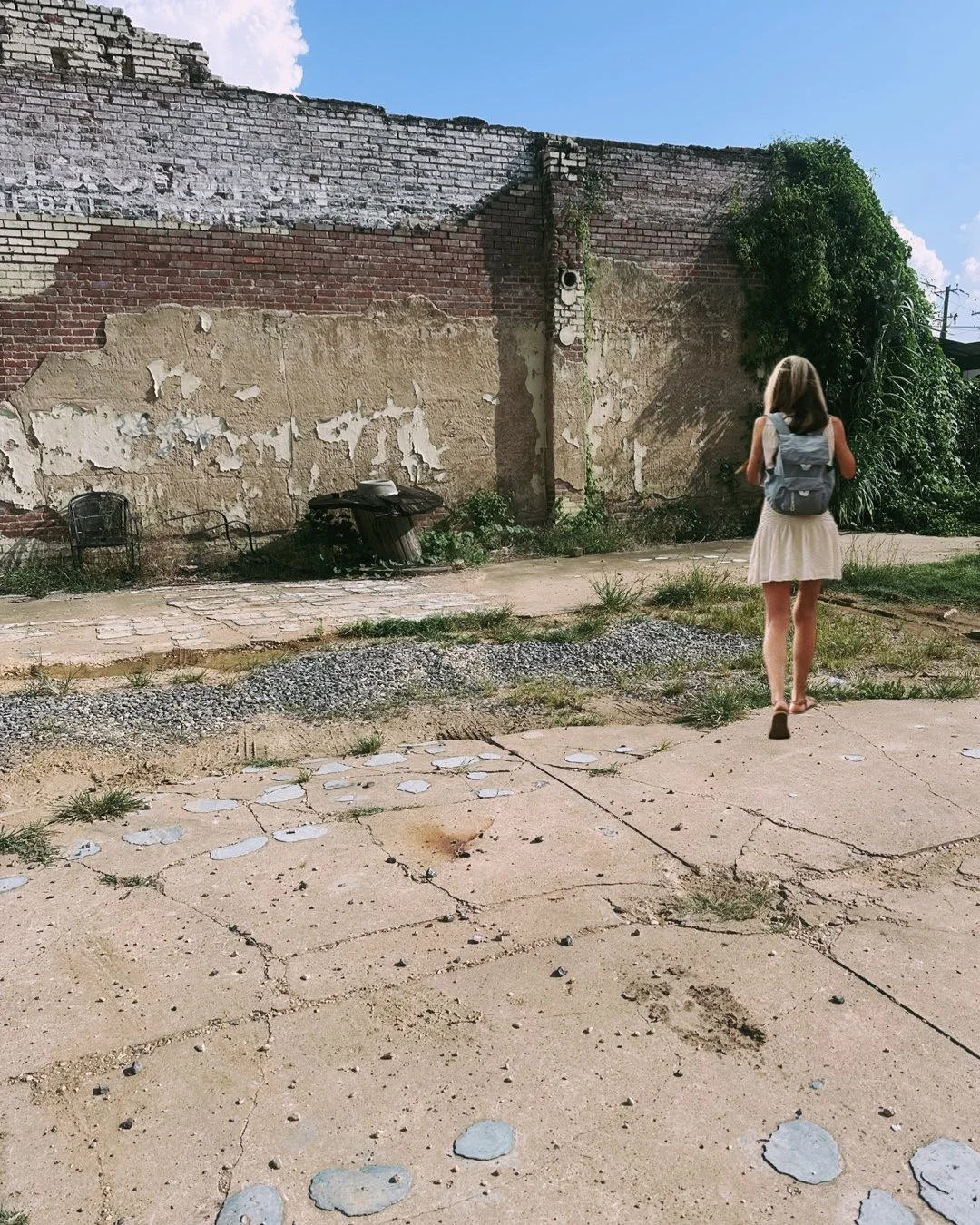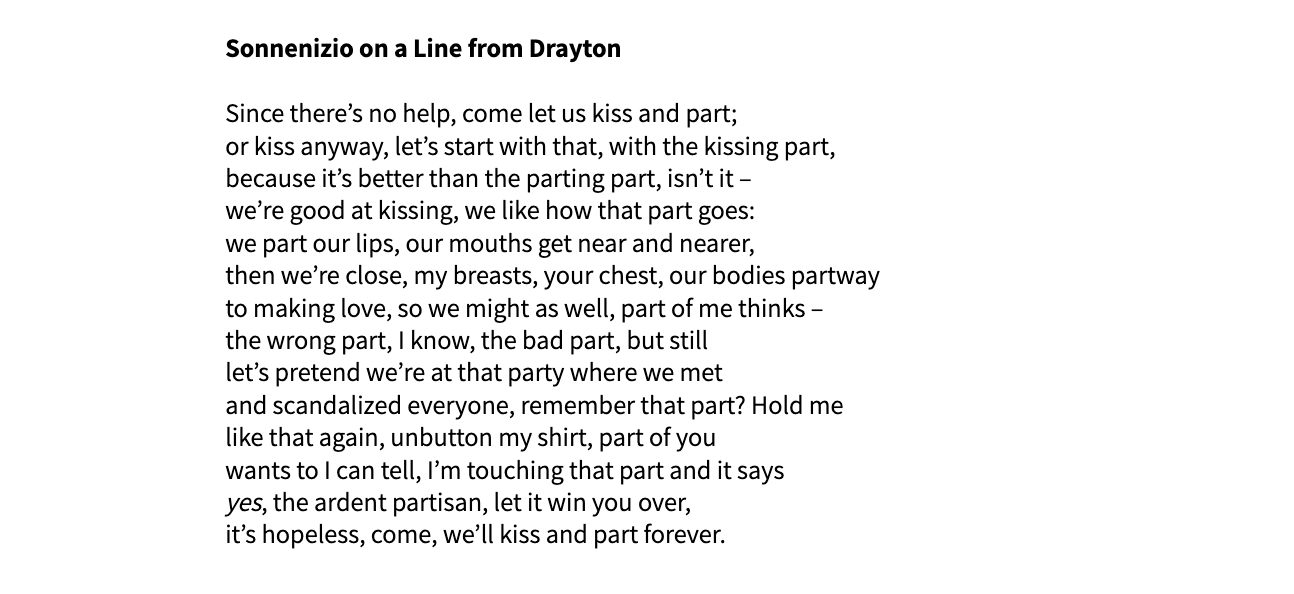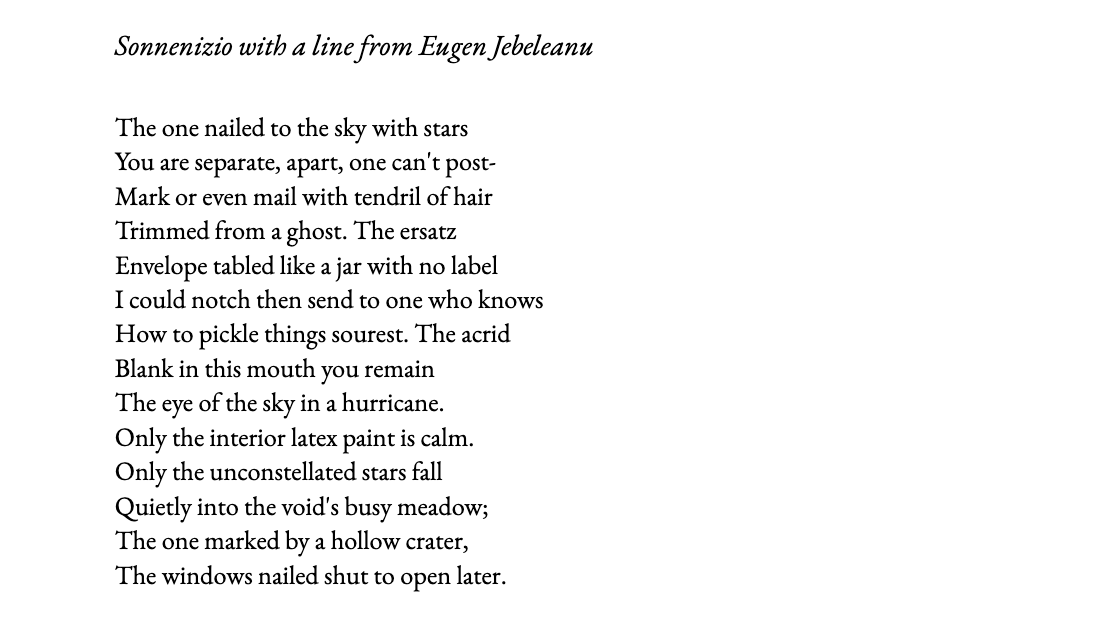MUSIC
Valentin Silvestrov’s Postludium No. 1 (“DSCH”) for Soprano, Violin, Cello and Piano (1981), as performed by Melanie Henley Heyn (soprano), Hee-Soo Yoon (violin), Jeffrey Ho (cello) and Vivian Hornik Weilerstein (piano). A haunting and spare tribute to DSCH (aka Shostakovich) . . . that accompanied my own writing today.
SONNENIZIO
I was reminded of the sonnenizio due to a tweet by Phillip Crymble today, and decided it might be fun to lay that nonce form nearer, and bring two other such creatures into the fray.
In What Is this Thing Called Love, poet Kim Addonizio introduced a new poetic form. Seemingly “lost by history,” the sonnenizio form was introduced with the following explanatory footnote:
The Sonnenizio was invented in Florence in the thirteenth century by Vanni Fucci as an irreverent form whose subject was usually the impossibility of everlasting love. Dante retaliated by putting Fucci into the seventh chasm of the Inferno as a thief. Originally composed of hendecasyllabics, the sonnenizio gradually moved away from metrical constraints and began to tackle a wider variety of subject matter. The sonnenizio is fourteen lines long. It opens with a line from someone else’s sonnet, repeats a word from that line in each succeeding line of the poem, and closes with a rhymed couplet.
So we have the bones of a sonnet with variations and adaptations. Here is Addonizio's first published sonnenizio:
The poem starts with the first line of a sonnet titled “Idea 61…” by the Elizabethan poet Michael Drayton.
Idea 61: Since there’s no help, come let us kiss and part
Since there’s no help, come let us kiss and part.
Nay, I have done, you get no more of me;
And I am glad, yea glad with all my heart,
That thus so cleanly I myself can free.
Shake hands for ever, cancel all our vows,
And when we meet at any time again,
Be it not seen in either of our brows
That we one jot of former love retain.
Now at the last gasp of Love’s latest breath,
When, his pulse failing, Passion speechless lies;
When Faith is kneeling by his bed of death,
And Innocence is closing up his eyes—
Now, if thou wouldst, when all have given him over,
From death to life thou might’st him yet recover!
Addonizio repeats the word “part” from the first line of Drayton’s sonnet throughout her own poem, which crosses time by connecting with the speaker of Drayton’s poem. She presses the part, and uses it as fulcrum for the poem’s motion and meaning. As noted by Poets Online, Addonizio” doesn't use any sonnet rhyming pattern, though other sonnenzios online do have rhyme. Some use a 14 line single stanza, some 8 & 6, or 4, 4, 4, and 2.”
The sonnenizio (which Addonizio invented, making splendid use of the footnote to craft a well-collared literary history for her nonceform) is enjoyable to write. Basically:
Take a line from someone else's sonnet and use it as your first line.
Repeat a word from that borrowed line in each of the succeeding 13 lines of the form.
Finish with a rhymed couplet.
Identify the original source of your opening line, whether in the epigraph or the title.
Edit with an eye to slight variations in the repeated word.
O, if and if you are looking to read a few more:
“Sonnenizio on a Line from Wendy Cope” by Arlene Ang
"Sonnenizio after a Line from Neruda” by Christine Swint
”Unplotted” by Susan Comninos
”[As nude upon some warm lawn softly turn]” by Michael Schiavo
”Sonnenizio on a Line from Elizabeth Barrett Browning” by Mona Anderson
”Sonnenizio on a Line from Shakespeare” by Clemmie Mendelsohn
”Sonnenizio on a Line from Yeats” by Catherine Rogers
And, tangentially, the form took on a new life when Michael Garrigan and Andrew Jones invented the songenizio, a form “born from the ancient art of making mixtapes”:
Songenizios is a collection of sixteen “sonnets” from Michael Garrigan and Andrew Jones. Each songenizio poem starts with a line from a song (based on playlists they made each other), repeats (in some form) one word from it in the following thirteen lines, and ends in a rhyming couplet. A collaboration between songs and sonnets, poets and musicians, this mixtape chapbook serves as a way to communicate across different mediums during the Covid-19 pandemic. All proceeds from the sale of this chapbook go to helping musicians through the Sweet Relief Musicians Fund.
PARADELLE
The paradelle form also has its own mythos. Originally, Billy Collins introduced his "Paradelle for Susan" with a note claiming that the paradelle originated in 11th century France. Here's the foot-note:
"The paradelle is one of the more demanding French fixed forms, first appearing in the langue d'oclove poetry of the eleventh century. It is a poem of four six-line stanzas in which the first and second lines, as well as the third and fourth lines of the first three stanzas, must be identical. The fifth and sixth lines, which traditionally resolve these stanzas, must use all the words from the preceding lines and only those words. Similarly, the final stanza must use every word from all the preceding stanzas and only these words."
But in the introduction to The Paradelle, a 2015 anthology published by Red Hen Press, Collins added more context:
A few years ago, I wrote a poem that I titled "Paradelle for Susan." It was the only paradelle ever to have been written because I invented the form in order to write the poem. What I set out to do was write an intentionally bad formal poem. Auden said there was nothing funnier than bad poetry, and I thought a horribly mangled attempt at a formal poem might have humorous results. I considered using an already existing form, but I figured enough bad sonnets and bad sestinas are already being written these days without me adding to the pile...The paradelle invites you in with its offer of nursery-rhyme repetition, then suddenly confronts you with an extreme verbal challenge. It lurches from the comfort of repetition to the crossword-puzzle anxiety of fitting a specific vocabulary into a tightly bounded space. While the level of difficulty in most verse forms remains fairly consistent throughout, the paradelle accelerates from kindergarten to college and back to kindergarten several times and ends in a think-tank called the Institute for Advanced Word Play. Thus the jumpy double nature of the paradelle, so unsteady, so schizo, so right for our times. . . .
The paradelle is parodic; it dances around the villanelle, and lifts its skirts for reaction. It pokes fun at the poet's sacrificing of sense on the altar of rigid formalism. But it is essentially parodic. Billy Collins invented this nonce to parody strict forms, particularly the villanelle. “Paradelle for Susan" ends cringely: "Darken the mountain, time and find was my into it was with to to.
A few paradelles, playing with this singy-songy hoax nonce:
Move your sea-warm come to me; will with me; spend
tender sounds, warning me the way of the seas, the seas.
— Annie Finch, “Paravaledellentine”
Round as mutation into the square
It is forcing the art, a sake for its own.
— Aric Gles, “Mutation Verse”
AMERICAN SENTENCE
In the history of strange forms, there is also the "American Sentence," a term coined by Allen Ginsberg to describe his response to the Japanese haiku. An American Sentence is one sentence consisting of 17 syllables.
Ginsberg’s example?
“Four skinheads stand in the streetlight rain chatting under an umbrella.
Write seventeen American sentences and see if you can find one to work into a poem. Alternately, write a poem that consists of American sentences and end it in an American question.


